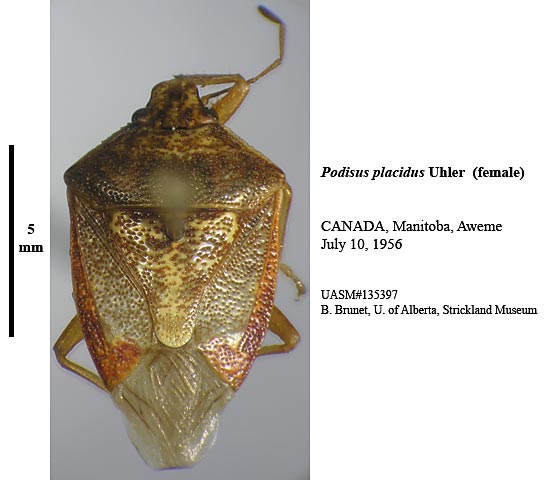Species Details
Podisus placidus
University of Alberta E.H. Strickland Entomological Museum Read more about this collection »
SeasonalityAdults appear in mid-April and are abundant until late-August, but can be found as late as October (Evans 1983; Oetting and Yonke 1971).
IdentificationThis species is lighter in coloration in comparison to other Podisus species. The dull-yellow mottling of the cuticle is much more prominent. The shape is somewhat quadrangular with the posterior of the dorsum nearly triangular shaped. The pronotal margins are straight-sided with broad, rounded projections on either side. This characteristic sets it apart from other Podisus species, as well as Apateticus bracteatus since these species generally have concave pronotal margins. The connexivum are nearly concealed under the hemelytra and the portions that are exposed have black spots along the margins of each abdominal segment. This is a relatively small species with a length of 7.5 to 9 mm (Blatchley 1926).
Scientific Name
Podisus placidus
Habitat
Evans (1983) reports this species in old-field habitats, as well as in both mixed and deciduous forests.
Seasonality
Adults appear in mid-April and are abundant until late-August, but can be found as late as October (Evans 1983; Oetting and Yonke 1971).
Identification
This species is lighter in coloration in comparison to other Podisus species. The dull-yellow mottling of the cuticle is much more prominent. The shape is somewhat quadrangular with the posterior of the dorsum…
This species is lighter in coloration in comparison to other Podisus species. The dull-yellow mottling of the cuticle is much more prominent. The shape is somewhat quadrangular with the posterior of the dorsum nearly triangular shaped. The pronotal margins are straight-sided with broad, rounded projections on either side. This characteristic sets it apart from other Podisus species, as well as Apateticus bracteatus since these species generally have concave pronotal margins. The connexivum are nearly concealed under the hemelytra and the portions that are exposed have black spots along the margins of each abdominal segment. This is a relatively small species with a length of 7.5 to 9 mm (Blatchley 1926).
Life History
There appears to be some discrepancy concerning the number of generations that occur in a season. McPherson (1982) indicates that the occurrence of both univoltine and bivoltine populations may exist within…
There appears to be some discrepancy concerning the number of generations that occur in a season. McPherson (1982) indicates that the occurrence of both univoltine and bivoltine populations may exist within northeastern N.A. Adults begin mating in early May shortly after emerging from hibernation. Females will deposit their eggs on the undersides of leaf surfaces an average of 1 egg mass per 5 days until the she dies (Oetting and Yonke 1971). Females can lay upwards of 300 eggs under laboratory settings (De Clercq 2000). Eggs take about 6 days to hatch and require temperatures of between 20° C to 25° C (De Clercq 2000; Oetting and Yonke 1971). Maturation to adult takes between 25 to 30 days (De Clercq 2000).
Conservation
This species has been implemented in several failed biological control attempts in Europe (De Clercq 2000).
Diet Info
This species is a polyphagous predator that feeds primarily on the larvae of Lepidoptera and Symphyta (Hymenoptera) as adults. Evans (1983) reports significant numbers feeding on forest-tent caterpillar, Malacosoma…
This species is a polyphagous predator that feeds primarily on the larvae of Lepidoptera and Symphyta (Hymenoptera) as adults. Evans (1983) reports significant numbers feeding on forest-tent caterpillar, Malacosoma americanum, colonies in Ithaca, New York, within the tents, as opposed to on the tents or in the areas surrounding them. It has been reported that they feed on plant juices as first instar nymphs (McPherson 1982).
Range
In North America, this species ranges from British Columbia to Quebec, Canada (Maw et al. 2000), and as far South as Arkansas, though these southerly records are generally restricted to eastern states (Henry and…
In North America, this species ranges from British Columbia to Quebec, Canada (Maw et al. 2000), and as far South as Arkansas, though these southerly records are generally restricted to eastern states (Henry and Froeschner 1988). It is not known whether it's distribution extends beyond North America. No specimens of this species have been collected in Alberta.
Notes
Oetting and Yonke (1971) report a detailed description of the egg and nymphal stages of this species. Here they report that nymphal instars can be effectively identified based on the width of the head and pronotum.
References
Author
Henry, T. J., and R. C. Froeschner
Title
Catalog of the Heteroptera, or true bugs, of Canada and the Continental United States.
Publication Date
1988
Pages
958 pp.
Author
Maw, H. E. L., Footit, R. G., Hamilton, K. G. A. and Scudder, G. G. E.
Title
Checklist of the Hemiptera of Canada and Alaska
Publication Date
2000
Pages
220 p.
Author
De Clerq, P.
Title
Heteroptera of Economic Importance.
Publication Date
2000
Pages
737-789
Author
Blatchley, W.S.
Title
Heteroptera or true bugs of Eastern North America with especial reference to the faunas of Indiana and Florida.
Publication Date
1926
Pages
1116 pp
Author
Oetting, R. D. and T. R. Yonke
Title
Immature stages and biology of Podisus placidus and Stiretrus fimbriatus (Hemiptera: Pentatomidae).
Publication Date
1971
Series Title
The Canadian Entomologist
Volume
103
Pages
1505-1516
Author
Evans, E. W.
Title
Niche relations of predatory stinkbugs (Podisus spp., Pentatomidae) attacking tent caterpillars (Malacosoma americanum, Lasiocampidae).
Publication Date
1983
Series Title
American Midland Naturalist
Volume
109
Pages
316-323
Author
McPherson, J. E.
Title
The Pentatomoidea (Hemiptera) of Northeastern North America, with emphasis on the fauna of Illinois
Publication Date
1982
Specimen Information
There is 1 specimen of this Species.
UASM135397 - Podisus placidus
University of Alberta E.H. Strickland Entomological Museum
Place CollectedCanada: Manitoba, Aweme
Collected ByBall, G. E.
Date Collected1956-07-10
